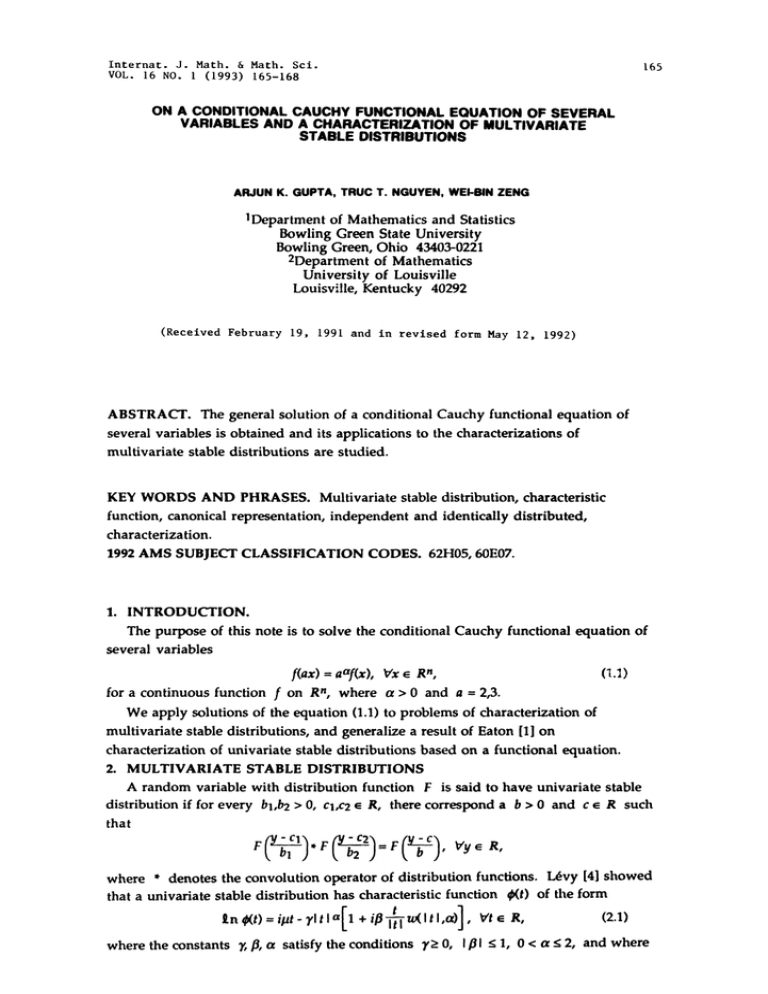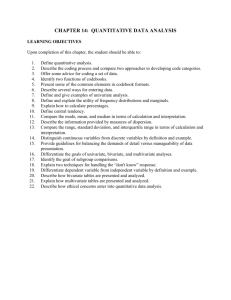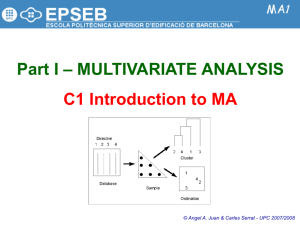1Department
advertisement

Internat. J. Math. & Math. Sci.
VOL. 16 NO.
(1993) 165-168
ON A CONDITIONAL CAUCHY FUNCTIONAL EQUATION OF SEVERAL
VARIABLES AND A CHARACTERIZATION OF MULTIVARIATE
STABLE DISTRIBUTIONS
ARJUN K. GUPTA, TRUC T. NGUYEN, WEI-BIN ZENG
1Department of Mathematics and Statistics
Bowling Green State University
Bowling Green, Ohio 43403-0221
2Department of Mathematics
University of Louisville
Louisv;.lle, Kentucky 40292
(Received February 19, 1991 and in revised form May 12, 1992)
ABSTRACT. The general solution of a conditional Cauchy functional equation of
several variables is obtained and its applications to the characterizations of
multivariate stable distributions are studied.
KEY WORDS AND PHRASES. Multivariate stable distribution, characteristic
function, canonical representation, independent and identically distributed,
characterization.
1992 AMS SUBJECT CLASSIFICATION CODES. 62H05, 60E07.
1. INTRODUCTION.
The purpose of this note is to solve the conditional Cauchy functional equation of
several variables
(1.1)
f(ax) aaf(x), ’x e R",
for a continuous function f on R n, where c > 0 and a 2,3.
We apply solutions of the equation (1.1) to problems of characterization of
multivariate stable distributions, and generalize a result of Eaton [1 on
characterization of univariate stable distributions based on a functional equation.
2. MULTIVARIATE STABLE DISTRIBUTIONS
A random variable with distribution function F is said to have univariate stable
distribution if for every bl,b2 > 0, cl,c2 R, there correspond a b > 0 and c R such
that
.
F
b!
*F
=F
l/y R,
where * denotes the convolution operator of distribution functions. Lvy [4] showed
that a univariate stable distribution has characteristic function t) of the form
(2.1)
tn(t)=it-,ltla 1 +i[J-i-w(Itl,a) ’t R,
where the constants y,/1, ot satisfy the conditions
’> 0, 1/11 a 1,
0< a
2, and where
166
A.K. GUPTA, T.T. NGUYEN AND .B. ZENG
kt is a real number. The function w(Itl,c0 is given by
tan
w(
if ot
1,
,a)
L
2
lLnltl, if a 1.
Multivariate generalizations of univariate stable distributions were introduced by
Ldvy [5] and Feldheim [2]. Let x denote an n x 1 vector. A multivariate distribution
G(x) is said to be multivariate stable if to every pair of scalars bl,b2 > 0, and real
vectors 1,c2 ( R n, there corresponds a scalar b > 0 and a real vector c Rn such
that
G
bl
=G
*G
’x Rn.
It has been shown that the characteristic function (t) of a multivariate stable
distribution has canonical representation
In t) ila’t- (t’t) 2
g!
+ ig2
’t e R n,
(2.2)
R n, gl and g2 are continuous functions on R n given by
integral representations (Lvy [5]). We remark that the explicit algebraic
representations of g! and g2 for multivariate stable distributions obtained by Press [7]
is not for all multivariate distributions. It is complemented by examples in
Paulauskas [6], indicating that the closed expressions of gl and g2, analogous to
where 0 < a < 2, /t
univariate case, are still unknown.
3. THE SOLUTIONS OF A CONDITIONAL CAUCHY FUNC’I’IONAL EQUATION
OF SEVERAL VARIABLES.
In this section, we will derive the general solution f of the Cauchy-type functional
equation (1.1), where at > 0 is given, and a 2,3.
Let S {sRnl
1}. For each se S, define Ga {rsir > 0}. Then R n is
partitioned into disjoint union of Ge, s e S, and {0}, i.e.
[[s[[
Let
f: R n
R be continuous solution of the equation (1.1). ,On each Ga, we have
f(ars) aaf(rs), Vr > 0,
where tx > 0, and a 2,3. By letting fs(r) f(rs), from Eaton (1966) and Gupta et al.
(1988) on solutions of a Cauchy equation of one variable, we get f(r) f(1)r u, ,’r > 0.
It follows that for x R n, x e 0,
If we let g(s) fs(1) where s is an element of S, then g is a continuous function on
S and
We obtained the general solution of the equation (1.1).
THEOREM 3.1. The general continuous solution f of the conditional Cauchy
functional equation (1.1) is of the form
CAUCHY FUNCTIONAL EQUATION OF SEVERAL VARIABLES
where g is an arbitrary continuous function on S.
An equivalent form of Theorem 3.1 is
THEOREM 3.1’. The general continuous solution
functional equation
f
where o > 0, and a
(a-x)
af (x),
Vx
f
167
of the conditional Cauchy
R n,
2,3, is given by
where g is a continuous function on S.
4. A CHARACTERIZATION OF MULTIVARIATE STABLE DISTRIBUTIONS
Applying Theorem 3.1’, we get the following characterization of multivariate
stable distributions.
THEOREM 4.1. Let XI,X2,X 3 be independent and identically distributed,
nondegenerate random vectors in R n. Then XI has a multivariate stable
0 < o < 2, such that
distribution with / 0 in (2.2) if and only if there is an
21/aXl and XI + X2, 31/aXl and XI + X2 + X3 are identically distributed,
respectively. In case a 1, all the univariate marginals of XI are Cauchy
distributed.
PROOF. We need only show the sufficiency. Let be the characteristic function
of XI. We first show that (t) 0, Vt R n. Suppose there is to Rn such that
t0) 0. Then the characteristic function of the univariate random variable tXl is
uto), with
t0) 0. In the proof of Theorem 3.1 of Gupta et al.
,
__txl(U)
__txl(1)
(1988), it is shown that if __#t6Xl (1)
<u<
and then 0)
0 then
tbxl(u)
0 for all
0 which is a contradiction. Hence
hl(t)+ih2(t)
(t) e
can be written as
or equivalently as,
.n (t)= hi(t) + ih2(t),
where hi and h2 are real-valued continuous functions on R n, the former is even
and the latter is odd.
The hypotheses imply that for some 0, 0 < a < 2, hl(al/at) ahl(t) and
h2(a
ah2(t), ’t Rn, a 2,3, and hence by Theorem 3.1’, hi and h2 are of the
form
and
Therefore by (2.2)
X1 has a multivariate stable distribution with location parameter
0.
In the case o 1 to show that all the univariate marginals of X1 are Cauchy
distributed, we are going to show that the first component of X1 is Cauchy
distributed, the Cauchy distributed of the other components of X1 are obtained by a
similar way.
Denoted by el a vector of R n having the first component equal to 1, and the
other components equal to zero. The characteristic function l of the first
vector /
A.K. GUPTA, T.T. NGUYEN AND W.B. ZENG
168
component is obtained by giving
every w R, that is,
wel in the characteristic function of X1, for
n l(W)= n we,> I1,
By he fac ha ] s an even function, 2 Js an odd function in he n
(-D 1(0, 2(-0 -2(0, respectively, for every
n @(w) w[gl(el) + ig2(el)] wgl(el) + iwg2(el), and if w < 0,
n (w) -wl(-el) + ig2(-el)] -wl(el)- ig2(el)] -wgl(el) + wg2(el). Therefore for
any w R, n (w) w gl(el) + iwg2(el), and 1 is the characteristic function of a
ave, Press [7] showed that for any mulvariate
stable disibufion, the characteristic function defined by (2.2) can
given by a simple
explicit algebraic form, but Paulauska [6] inted out that the form given by Press is
only ue for a class of multivariate stable disibutions, and that the cl forms of
gl and g2 are still unknown, except for the case a 2, g2(t) 0, and g(t) t’t for
some sifive definite n x n matrix
THEOM 4.2. t X,X2 X9
indendent and identically disibut
random vectors in R n.
(i) X1 has a multivariate normal distribution (ssibly degenerate) with zero
location vector if and only if l and X + X2 + X3 + X4, 3Xl and X1 + X2 + + X9
are idencally distributed, restively.
(ii) X has a multivariate stable distribution with Cauchy marginals if and only if
l d X + X 3Xl and Xl + X2 + X3 are identically disibuted, resctively.
PROF. e prf follows along the exact same lines as that of eorem 4.1 by
using rem 3.1 with a 1 or 2, instead of Threm 3.1’.
Cauchy disibution. As mentioned
.
ACKNOWLEDGEMENT. The authors thank the referees for the useful comments
and suggestions.
REFERENCES
1.
2.
EATON, M.L., Characterization of distributions by the identical distribution of linear
forms, J. Appl. Prob. (1966), 481-494.
FELDHEIM, M.E., ]tude de !e stabilitY, des loi_._s d_e probabilitY, Thse de la Facult des
Sciences de Paris.
3.
4.
5.
functional
GUPTA, A.K.; NGUYEN, T.T. & ZENG, W.B., On conditional
equation and _a characterization of tabl distributions. Bowling Green State Univ.,
Dept. of Mathematics & Statistics, Technical Report No. 88-16, 1988.
L]VY, P., Theorie des Erreurs: La Loi de Gauss et lea Exceptionelles, Bull. Soc. Math.
France 52 (1924), 49-85.
L]VY, P., Theorie de l’Addition de._.s Variables Alatoires 2nd ed., Ganthier-Villars, Paris,
1937.
6.
PAULAUSKAS, V.J., Some remarks
Anal_____:.
7.
on multivariate stable distributions,
J.
lu|tivariate
(1976), 356-368.
PRESS, S.J., Multivariate stable distributions, J. Multivariate Anal. (1972), 444-462.




